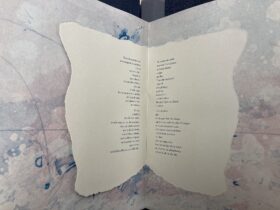Orlando furioso by M. Lodovico Ariosto. Venetia : V. Valgrisio. 1560.
This late Renaissance book, Orlando Furioso (literally Mad Orlando) has a full calf binding with triple ruled borders in blind on the front and back covers. A gilt decorative medallion is tooled on the center of each cover. There are penciled notes on the front free endpaper: “Notes by Rich Feul (sp ?) at the end. Corrected by the Inquisition. contain passages struck out…pl by Dosso Dossi Ferrara.”
The title page is framed by an architectural panel. On the lintel is the portrait of a bearded Ariosto with laurel wreath, called ’Divine Ludovico Ariosto’. Two winged figures on the roof stretch forward with additional laurel wreaths in their hands. Columns at the sides, caryatides shaped. Beneath the title two angels bring forward an oval with Vincenzo Valgrisi’s device (two hands holding a wooden Tau with entwined snake. His name in the middle: VINCENT. Motto : ’Ita exaltari oportet filium hominis, sicut Moyses exaltavit serpentem in deserto’).
Forty-six full-page woodcuts at the opening of every canto, illustrating the content, surrounded by an elaborate border. (Supposedly, the drawings from which the cuts originated, have been the work of Dosso Dossi (1489-1542), official painter of the Este court in Ferrara and Ariosto’s close friend). The subjects of the cantos also are contained in richly decorated frames. The cuts represent sequences of scenes described in the cantos, to be read at different levels, with each illustrated character recognizable by his initials engraved underneath.
There woodcut historiated initials, 36 x 36 mm. and 24 x 24 mm. On p. 551, at the opening of Ruscelli’s ’Annotazioni et avvertimenti’ Valgrisi’s device is printed a second time, in a slightly different variant, of larger size, without motto.
The partial title and author’s name are lettered in black on the fore-edge.
The first version of this epic poem was written in 1516 by Ludovico Ariosto. However, the poem was not published in its complete form until 1532. Orlando Furioso is a continuation of Matteo Maria Boiardo’s unfinished romance Orlando Innamorato (“Orlando in Love”, published posthumously in 1495). The action takes place against the background of the war between Charlemagne’s Christian paladins and the Saracen army that is attempting to invade Europe. Ariosto has little concern for historical or geographical accuracy, and the poem wanders at will from Japan to the Hebrides, as well as including many fantastical and magical elements (such as a trip to the moon, and an array of fantastical creatures including a gigantic sea monster called the orc, and the hippogriff). Many themes are interwoven in its complicated episodic structure, but the most important plot is the paladin Orlando’s unrequited love for the pagan princess Angelica, which develops into the madness of the title. After this comes the love between the female Christian warrior Bradamante and the Saracen Ruggiero, who are supposed to be the ancestors of Ariosto’s patrons, the d’Este family of Ferrara.
If you would like to view this famous poem, please visit the Binghamton University Special Collections department.







